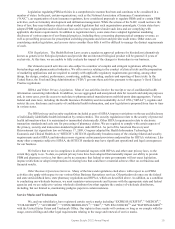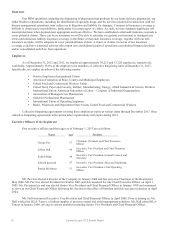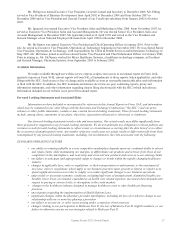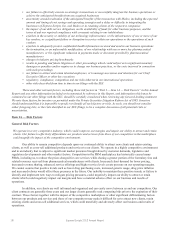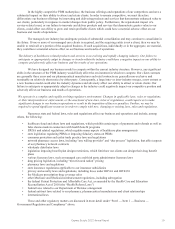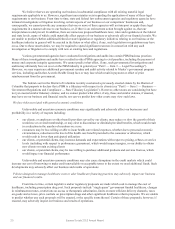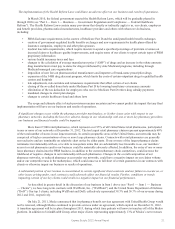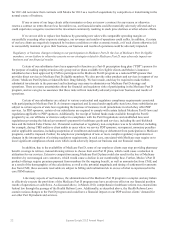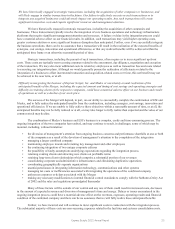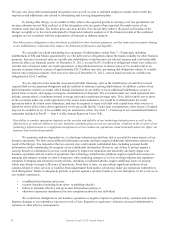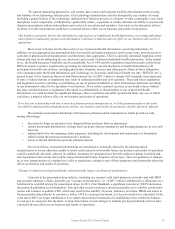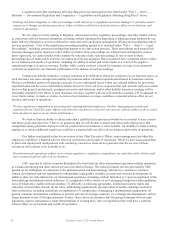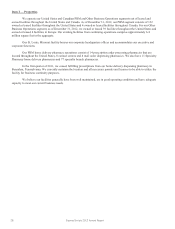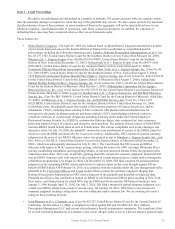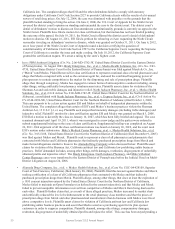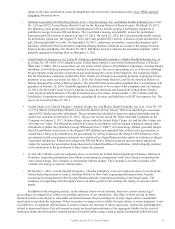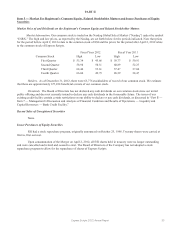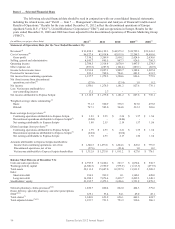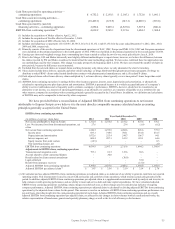Express Scripts 2012 Annual Report Download - page 27
Download and view the complete annual report
Please find page 27 of the 2012 Express Scripts annual report below. You can navigate through the pages in the report by either clicking on the pages listed below, or by using the keyword search tool below to find specific information within the annual report.
Express Scripts 2012 Annual Report 25
Q
Q
Q
Q
We operate dispensing pharmacies, call centers, data centers and corporate facilities that depend on the security
and stability of our technology infrastructure. Our technology infrastructure could be disrupted by any number of events
including a general failure of the technology, malfunction of business process or a disaster or other catastrophic event. Such
disruptions could, temporarily or indefinitely, significantly reduce, or partially or totally eliminate our ability to process and
dispense prescriptions and provide products and services to our clients and members. Any such service disruption at these
facilities or to this infrastructure could have a material adverse effect on our business and results of operations.
Our business operations involve the substantial receipt and use of confidential health information concerning individuals
and a failure to adequately protect such information could have a material adverse effect on our business and results of
operations.
Most of our activities involve the receipt or use of protected health information concerning individuals. In
addition, we use aggregated and anonymized data for research and analysis purposes, and in some cases, provide access to
such data to pharmaceutical manufacturers and third party data aggregators. There is currently substantial regulation at the
federal and state levels addressing the use, disclosure and security of patient identifiable health information. At the federal
level, the Health Insurance Portability and Accountability Act of 1996 and the regulations issued thereunder (collectively
HIPAA) impose extensive requirements governing the transmission, use and disclosure of health information by all
participants in health care delivery, including physicians, hospitals, insurers and other payors. Many of these obligations
were expanded under the Health Information and Technology for Economic and Clinical Health Act (the “HITECH Act”),
passed as part of the American Recovery and Reinvestment Act of 2009. Failure to comply with standards issued pursuant
to state or federal statutes or regulations may result in criminal penalties and civil sanctions. These and future regulations
and legislation severely restricting or prohibiting our use of patient identifiable or other information could limit our ability
to use information critical to the operation of our business. If we violate a patient’s privacy or are found to have violated
any state or federal statute or regulation with regard to confidentiality or dissemination or use of protected health
information, we could be liable for significant damages, fines or penalties and suffer reputational harm, any one of which
could have a material adverse effect on our business and results of operations.
If we lose our relationship with one or more key pharmaceutical manufacturers, or if the payments made or discounts
provided by pharmaceutical manufacturers decline, our business and results of operations could be adversely affected.
We maintain contractual relationships with numerous pharmaceutical manufacturers which provide us with,
among other things:
Q discounts for drugs we purchase to be dispensed from our home delivery pharmacies
Q rebates based upon distributions of drugs from our home delivery pharmacies and through pharmacies in our retail
networks
Q administrative fees for managing rebate programs, including the development and maintenance of formularies
which include the particular manufacturer’s products
Q access to limited distribution specialty pharmaceuticals
If several of these contractual relationships are terminated or materially altered by the pharmaceutical
manufacturers or we are otherwise unable to renew such contracts on favorable terms, our business and results of operations
could be materially adversely affected. In addition, formulary fee programs have been the subject of debate in federal and
state legislatures and various other public and governmental forums. Adoption of new laws, rules or regulations or changes
in, or new interpretations of, existing laws, rules or regulations, relating to any of these programs could materially adversely
affect our business and results of operations.
Changes in industry pricing benchmarks could materially impact our financial performance.
Contracts in the prescription drug industry, including our contracts with retail pharmacy networks and with PBM
and specialty pharmacy clients, generally use “average wholesale price” or “AWP,” which is published by a third party as a
benchmark to establish pricing for prescription drugs. In 2011, First DataBank, a significant provider of AWP information,
discontinued publishing such information. This and other recent events have raised uncertainties as to whether certain third
parties will continue to publish AWP, which may result in the inability of payors, pharmacy providers, PBMs and others in
the prescription drug industry to continue to utilize AWP as a pricing benchmark as it has previously been calculated. In the
event that AWP is no longer published or if we adopt other pricing benchmarks for establishing prices within the industry,
we can give no assurance that the short- or long-term impact of such changes to industry pricing benchmarks will not have
a material adverse effect on our business and results of operations.


